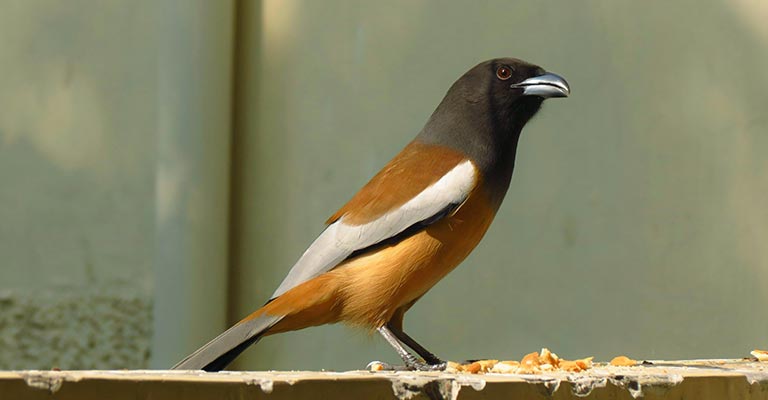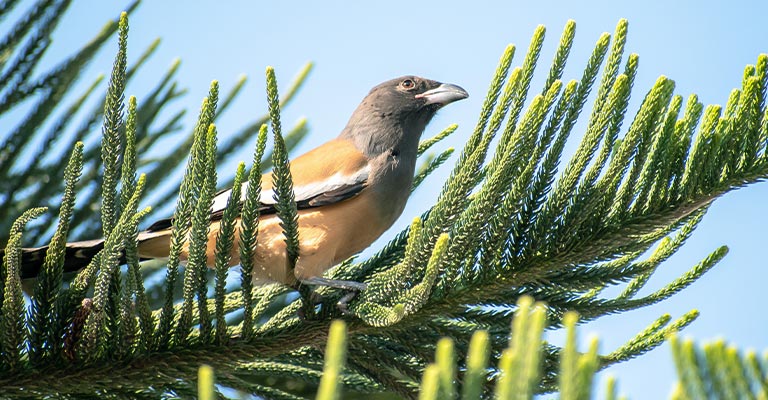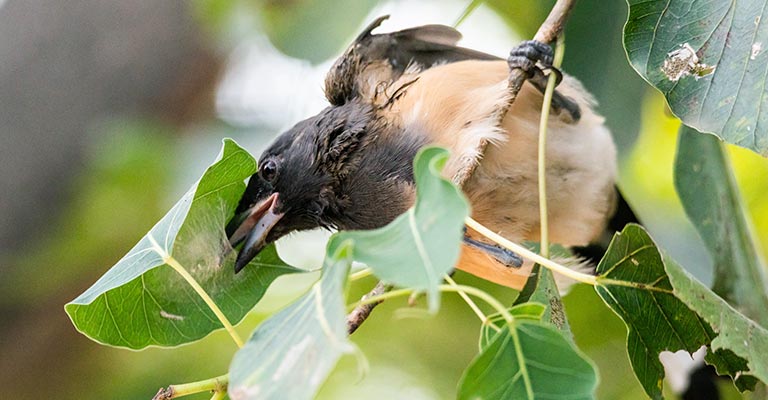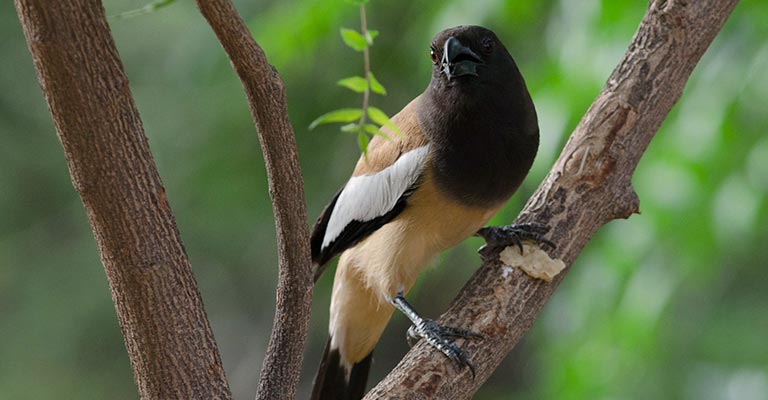In my birdwatching years, I’ve encountered some genuinely remarkable species. One that constantly stands out is the Rufous Treepie.
This bird’s striking appearance, characterized by its long, fan-shaped tail and contrasting black and cinnamon plumage, is a sight to behold.
Native to the Indian Subcontinent and adjoining parts of Southeast Asia, the Rufous Treepie is a member of the crow family. It’s a bold, agile bird known for loud musical calls and acrobatic flight.
The Rufous Treepie’s fascinating behaviors and adaptability to various habitats make it a captivating subject for bird enthusiasts like myself.
Physical Characteristics of the Rufous Treepie

The Rufous Treepie (Dendrocitta vagabunda) is a striking bird belonging to the corvid family, known for its vibrant colors and distinct physical features.
Here are some key characteristics:
Coloration
The Rufous Treepie is named for its rufous or cinnamon-colored body, with a black head and neck. Its long, graduated tail displays shades of bluish-gray with a black tip.
The wings feature a white patch, contrasting with the black primaries. Its bill, legs, and feet are black, adding to its visually striking appearance.
Size and Weight
This bird is of medium size, typically measuring between 45 to 55 centimeters in length, including its tail. It weighs anywhere from 80 to 140 grams. While males and females look similar, males tend to be slightly larger.
Adaptations for Tree Dwelling
The Rufous Treepie is well-adapted for its arboreal lifestyle. It possesses a strong, hooked bill that aids in foraging and tearing apart prey. Its long, curved claws let it grip onto branches securely, while its agile nature enables it to move through trees quickly.
Dietary Habits
As an omnivore, the Rufous Treepie has a varied diet. It feeds on fruits, seeds, insects, spiders, worms, snails, small reptiles, eggs, nestlings of other birds, and carrion. It is also known to cache food for later consumption and steal from other birds.
Vocalizations
The Rufous Treepie is a vocal bird, producing a range of calls, including its signature metallic “know Kroo” call. It also emits whistles, chatters, and squeaks and can mimic the sounds of other birds and animals.
Breeding Behavior
This species forms monogamous pair bonds that can last for several years. The breeding season varies but generally occurs from February to September. Nests are shallow cups of twigs, grasses, and roots lined with finer materials such as hair and feathers.
They are typically built on tree branches 3 to 15 meters above the ground. Both parents incubate the eggs and jointly care for the chicks until they fledge.
Habitat and Distribution of the Rufous Treepie

The Rufous Treepie is known for its remarkable adaptability, which enables it to thrive in various habitats across its native range in the Indian Subcontinent and Southeast Asia, as well as in scattered locations beyond:
Native Range
The primary habitats of the Rufous Treepie include dense forests and wooded areas within the Indian Subcontinent and Southeast Asia. These regions provide ample food sources, nesting sites, and cover for the birds to flourish.
Urban Environments
While their preferred habitats are wooded areas, Rufous Treepies demonstrate the ability to adapt to urban environments. They can be found in cities, towns, and suburban areas, which utilize parks, gardens, and green spaces as suitable habitats.
Their boldness and resilience contribute to their success in urban settings.
Global Distribution
In addition to their native range, Rufous Treepies have been observed in scattered locations beyond the Indian Subcontinent and Southeast Asia.
These sightings indicate their dispersal and colonization of diverse ecosystems, showcasing their adaptability to varying environmental conditions.
Behaviors and Adaptations of the Rufous Treepie

The Rufous Treepie exhibits various behaviors and adaptations, contributing to its remarkable survival and success in diverse environments.
Audacious and Adventurous Demeanor
These birds are known for their bold and adventurous nature, constantly exploring and expanding their territories. This behavior likely helps them find new food sources and nesting sites while avoiding competition.
Continuous Exploration
Rufous Treepies are not content with a sedentary lifestyle; they are always on the move, reflecting their insatiable curiosity and desire for discovery. This behavior allows them to remain adaptable and resourceful in changing environments.
Vocalizations
Their distinctive vocalizations, including chatters and clucks, serve various purposes, such as communication within their social groups, marking territory, and attracting mates. These vocalizations also help them navigate through dense foliage and coordinate during hunting.
Courtship Displays
Rufous Treepies engage in elaborate courtship displays that showcase their agility and flair. These displays are essential for pair bonding and mate selection, ensuring reproductive success.
Hunting Strategies
Rufous Treepies are opportunistic hunters, using their strong beaks and agile claws to forage for various prey, including insects and fruits. Their adaptability in hunting tactics allows them to exploit different food sources depending on availability and season.
Adaptability to Different Environments
These birds demonstrate remarkable adaptability to various habitats, from forests to urban areas. Their ability to thrive in different environments reflects their resilience and versatility as a species.
Survival Tactics
Rufous Treepies employ survival tactics such as fat storage to endure harsh conditions, such as winters when food becomes scarce. This adaptation enables them to survive and even thrive in challenging environments.
Strength and Resistance
The Rufous Treepie’s strength and resistance to environmental pressures are evident in their ability to cope with changing conditions and survive in diverse habitats.
Conservation Status of the Rufous Treepie

The Rufous Treepie (Dendrocitta vagabunda) is currently classified as “Least Concern” by the International Union for Conservation of Nature (IUCN).
This designation indicates that the species is not facing immediate threats to its survival and is relatively stable in population size and distribution.
Factors contributing to the Rufous Treepie’s resilience and adaptability include:
Flexibility in Diet
Rufous Treepies are omnivorous, consuming diverse food items, including invertebrates, small reptiles, fruits, and seeds. This dietary flexibility allows them to exploit various food sources, reducing their vulnerability to changes in habitat and prey availability.
Nesting Adaptability
These birds construct nests well-hidden in dense foliage or elevated in forest canopies. This adaptability in nesting locations helps them avoid predators and disturbances, ensuring successful breeding despite habitat changes.
Despite their ability to thrive in diverse environments, the Rufous Treepie faces specific threats:
Habitat Loss
Extensive deforestation and urbanization lead to the loss and fragmentation of their natural habitats. Fragmented habitats can disrupt their foraging and breeding behaviors, reducing their reproductive success.
Pesticide Use
Agricultural areas where pesticides are used threaten the Rufous Treepie by reducing the availability of prey species and potentially causing direct harm to the birds through exposure to toxic chemicals.
Conclusion
Rufous Treepie’s story is a testament to the power of adaptability in the face of adversity. It’s a bird that’s not just surviving but thriving despite the environmental challenges thrown its way.
Its ability to adjust its diet and nesting habits is a lesson for us all in resilience. Yet, it’s not immune to habitat fragmentation and pesticide threats.
We must remember that their survival is a delicate balance, and it’s our responsibility to ensure that balance isn’t tipped.
The Rufous Treepie serves as a reminder of the incredible resilience of nature and the importance of our role in preserving it.